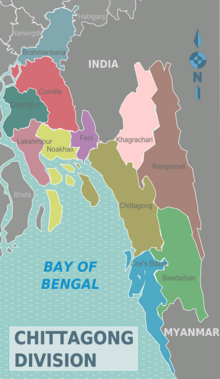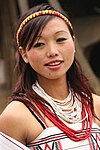Chakma people
[5] Most modern Chakma people practice Theravada Buddhism, due to 19th-century reforms and institutionalisation by Queen regnant Rani Kalindi.[citation needed] The modern linguistic study suggests that the term "Chakma" originates from two constituent words: "Tsak" and "Ma".In this context, "Tsak" is believed to be derived from "Shak" which is associated with the Shakya clan, and "Ma" signifies "man" in Tibeto-Burmese languages.After their defeat by the Arakanese, the Chakmas migrated to the present Chittagong Hill Tracts and founded their capital city Alekyangdong (present-day Alikadam).[citation needed] Three years after the Battle of Plassey, Mir Qasim, the new Nawab of Murshidabad, rewarded the East India Company with Chittagong, Burdwan and Midnapur.[citation needed] Encroachments on the Chittagong Hill Tracts by the British led to a protracted war between the East India Company and the Chakmas from 1777 to 1787.[16] The main provisions of the treaty between Governor-General Lord Cornwallis and the Chakma king were as follows:[18] In 1829, Halhed, then Commissioner of Chittagong, reaffirmed that: The hill tribes were not British subjects but merely tributaries and we recognized no right on our part to interfere with their internal arrangements.These sums were at first fluctuating in amount but gradually were brought to a specific and fixed limit, eventually taking the shape not of tribute but of revenue to the state.[19]: 35 After Rani Kalindi's death in 1873, her grandson Harish Chandra became the Chakma Raja and was vested with the title Roy Bahadur.[15]: 29 As a consequence, with a view to paying attention to the areas experiencing repeated raids and to protecting the people from the aggression of the independent tribes living further east but primarily to occupy the Chakma land, the Lieutenant Governor of Bengal recommended the removal of the hill tracts from the regulation district and the appointment of a superintendent over the tribes.The official designation of the post of superintendent was changed to Deputy Commissioner and full control of matters about revenue and justice throughout the Hill Tracts was vested in his office.Hence, they wished to lay the foundation of administration in a restricted manner with the following objectives:[15]: 30 After the creation of a separate district and the three circles, the Kuki (Lushai) threat to the Chittagong Hill Tracts and other adjoining areas did not stop.During World War II, to retain Chakma loyalty in the face of Japanese advances, local British officials guaranteed the tribals that the Chittagong Hill Tracts would be split of separately in the event of Indian independence.[16] In British India, there was a measure of security and protection afforded to the non-Muslim and non-Bengali Chittagong Hill Tract Chakmas and other tribal people.It was the fact that the CHT was governed under a different set of rules since 1900 in order to prevent mainlanders from acquiring ownership of the tribal land.Recent migrations of ethnic Bengalis into traditionally Chakma regions of Bangladesh have raised tensions in the Chittagong Hill Tracts.Pakistani president Yahya Khan assigned a south-east Asian diplomatic post to Tridiv Roy during the war as a reward for his collaboration.Roy chose the Pakistani side, fearing that an independent Bangladesh would likely have democratic rule and he might lose his feudal interests.Pakistan retained his support and allegiance, Roy agreed on 25 March, and in exchange British artillery would refrain from shelling the CHT capital, Rangamati.[44][45] Parbatya Chattagram Jana Samhati Samiti (PCJSS; Chittagong Hill Tracts Peoples Solidarity Association), which was founded by Chakmas, demanded a halt to Bengali settlement, settlers returning lands to CHT natives, and autonomy.Bhutto assigned the position of Minorities Affairs Minister to Roy and he helped lobby the United Nations (UN) for Pakistan after the war.[54] Meghalaya and Tripura were destinations of Buddhist Chakma refugees fleeing from the war started by plains-dwelling Muslim Bangladeshis settling the CHT, as well as the government of Bangladesh implementing a military police force to expel Chittagong Hill Tracts natives.[62] The Chittagong Hill Tracts saw tribal Chakma leave the area due to religious and ethnic strife caused by Bangladesh's Islamisation policy.The Election Commission of India framed guidelines to enable Chakmas to have the right to vote by having their names enrolled in the electoral rolls of the constituency where they have been settled.[69] The only seat of political power and identity is the Chakma Autonomous District Council in India, the legitimacy of which is questioned by the Mizo people.Houses are decorated with flowers, young children pay special attention to the elderly to win their blessings, visiting Buddhist monasteries, and preparing festive and traditional Chakma dishes for guests are some of the important things.In the context of its nature, some say that Bizu is a festival, which revolves around agricultural activities because it is celebrated in mid-April when the earth is just drenched with the first rain and the zhum sowing is taken up.The Buddhist monks known as Bhante lead the devotees for the chanting of verses composed in Pali[78] in praise of the holy triple gem:[79] the Buddha, the Dharma (his teachings), and the Sangha (his disciples).They take turns sending a player into opposing territory to touch as many people as they can during the space of one breath, while at the same time saying "Ha-do-do."Chakma is written in an alphabet that allows for its cursive form, and is almost identical to the Khmer and the Lanna (Chiangmai) characters, which was formerly in use in Cambodia, Laos, Thailand and southern parts of Burma.



Naga woman
BangladeshMyanmarMizoramTripuraArunachal PradeshWest BengalMeghalayaNagalandChakmaTheravada BuddhismDaingnetTanchangyaRakhineUpazilaChittagong DivisionKhagrachhariRangamatiBandarban districtsnationIndian subcontinentWestern MyanmarChittagong Hill TractsChakma Autonomous District Councilnortheast IndianTibeto-Burmanlanguage shiftIndo-AryanChittagonian languageQueen regnantRani KalindiChakma Rajagovernment of British Indiagovernment of BangladeshRakhine StatePamela GutmanSanskritBagan EraShakyaTibeto-BurmeseBrahmi scriptArakanese peopleMin BinArakan MountainsDiego de AstorBengalJoão de BarrosKarnaphuli RiverChittagong BangladeshMin RazagyiFilipe de Brito e NicoteAlikadamRanguniaRaozanFatikchari UpazilasMughalShaista KhanRanirhatBattle of PlasseyMir QasimMurshidabadBurdwanMidnapurHarry VerelstSubedarhegemonyEast India CompanyCalcuttaLord CornwallisSepoy MutinyShraavanaFeni RiverRoy BahadurLushaiCacharNoakhaliComillaChandraghonaChakma CircleBohmong CircleMong CircleShendusLushai HillsAssam ProvinceAizawlChittagong Hill Tracts manualGovernment of India Act 1935Indian national movementWorld War IICyril RadcliffeindependenceLord MountbattenBangladeshi ConstitutionEast PakistanKaptai DamUnited States Agency for International DevelopmentManabendra Narayan LarmaTridev RoyYahya KhanAwami LeagueSheikh Mujibur RahmanRazakarsBangladesh Liberation WarBengalisParbatya Chattagram Jana Samhati SamitiShanti BahiniMukti BahiniParliament of PakistanNurul AminGaro peopleBengali nationalismIslamisationBurmesethe Citizenship Act, 1955Chittagong Hill Tracts Peace AccordMizoram Legislative AssemblyTripura Legislative AssemblyTripura Tribal Areas Autonomous District CouncilMizo peopleDaingnet peopleRangamati Hill DistrictKhagrachhari District Juraichhari Upazila Naniarchar UpazilaBarkal Upazila Bagaichhari Upazila Dighinala Upazila